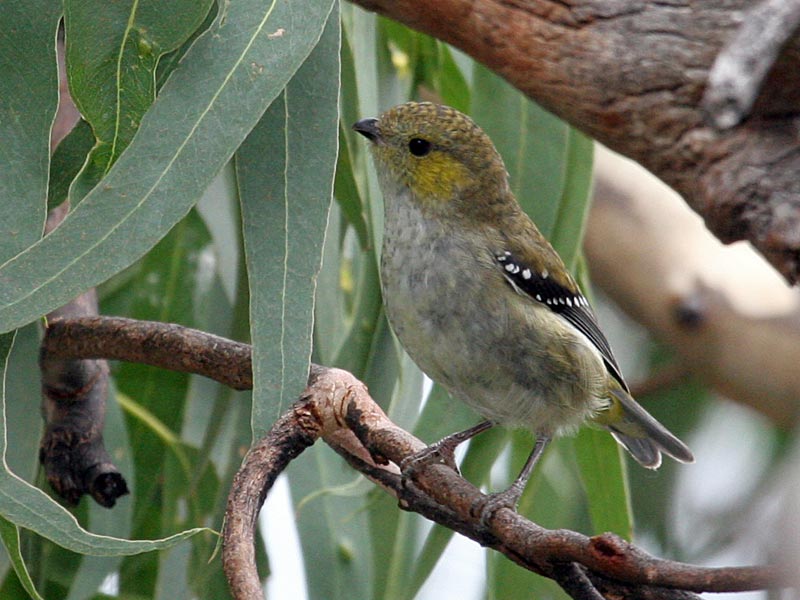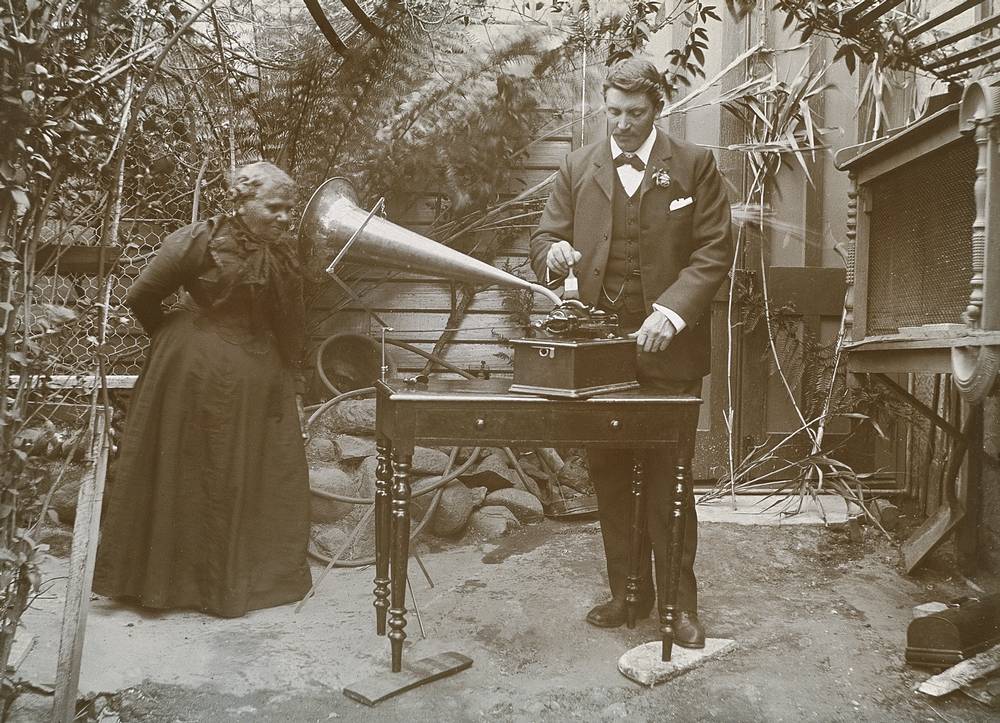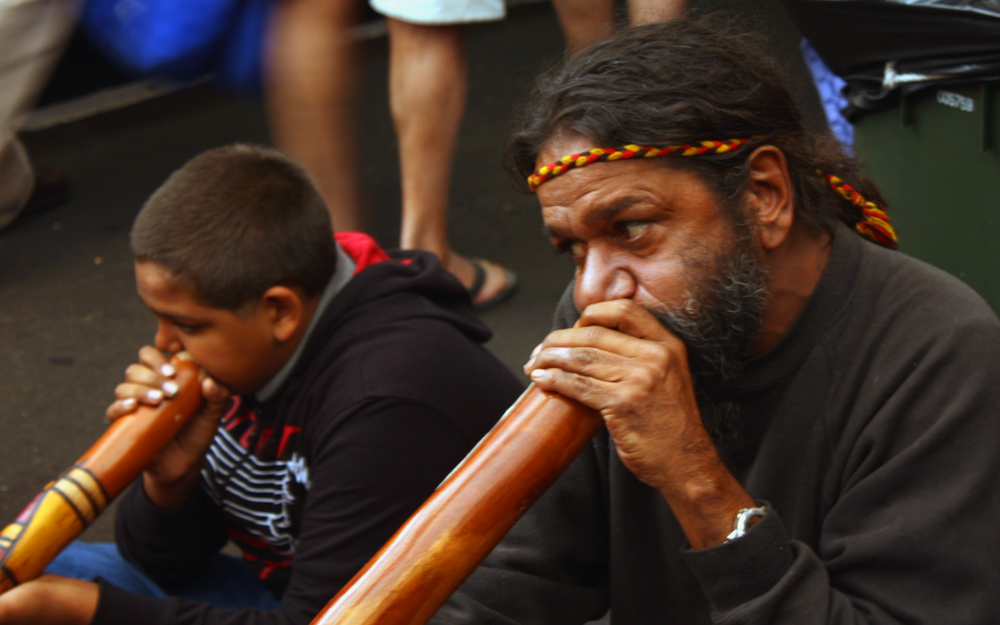|
Fanny Cochrane Smith
Fanny Cochrane Smith (December 1834 – 24 February 1905) was an Aboriginal Tasmanian, born in December 1834. She is considered to be the last fluent speaker of the Flinders Island lingua franca, a Tasmanian language, and her wax cylinder recordings of songs are the only audio recordings of any of Tasmania's indigenous languages. Her recordings were inducted into the UNESCO Australian Memory of the World Register in 2017. Early life Fanny Cochrane's mother Tanganutura and a man named Nicremeric or Nicermenic, sometimes reported as her father, were two of the Tasmanian Aboriginals settled on Flinders Island in the 1830s by George Augustus Robinson; according to Norman Tindale her father was Cottrel Cochrane, of European descent, and Nicremeric was her stepfather. She was born at Settlement Point (or Wybalenna, meaning Black Man's House) on Flinders Island. No indigenous name is known; Robinson gave European names to all the Indigenous Tasmanians who arrived at the island as part ... [...More Info...] [...Related Items...] OR: [Wikipedia] [Google] [Baidu] |
Flinders Island
Flinders Island, the largest island in the Furneaux Group, is a island in the Bass Strait, northeast of the island of Tasmania. Flinders Island was the place where the last remnants of aboriginal Tasmanian population were exiled by the colonial British government. Today Flinders Island is part of the state of Tasmania, Australia. It is from Cape Portland and is located on 40° south, a zone known as the Roaring Forties. History Prehistory Flinders Island was first inhabited at least 35,000 years ago, when people made their way from Australia across the then land-bridge which is now Bass Strait. A population remained until about 4,500 years ago, succumbing to thirst and hunger following an acute El Niño climate shift. European discovery Some of the south-eastern islands of the Furneaux Group were first recorded in 1773 by British navigator Tobias Furneaux, commander of , the support vessel with James Cook on Cook's second voyage. In February 1798, British navigator Ma ... [...More Info...] [...Related Items...] OR: [Wikipedia] [Google] [Baidu] |
Methodism
Methodism, also called the Methodist movement, is a group of historically related denominations of Protestant Christianity whose origins, doctrine and practice derive from the life and teachings of John Wesley. George Whitefield and John's brother Charles Wesley were also significant early leaders in the movement. They were named ''Methodists'' for "the methodical way in which they carried out their Christian faith". Methodism originated as a revival movement within the 18th-century Church of England and became a separate denomination after Wesley's death. The movement spread throughout the British Empire, the United States, and beyond because of vigorous missionary work, today claiming approximately 80 million adherents worldwide. Wesleyan theology, which is upheld by the Methodist churches, focuses on sanctification and the transforming effect of faith on the character of a Christian. Distinguishing doctrines include the new birth, assurance, imparted righteousness, ... [...More Info...] [...Related Items...] OR: [Wikipedia] [Google] [Baidu] |
National Film And Sound Archive
The National Film and Sound Archive of Australia (NFSA), known as ScreenSound Australia from 1999 to 2004, is Australia's audiovisual archive, responsible for developing, preserving, maintaining, promoting and providing access to a national collection of film, television, sound, radio, video games, new media, and related documents and artefacts. The collection ranges from works created in the late nineteenth century when the recorded sound and film industries were in their infancy, to those made in the present day. The NFSA collection first started as the National Historical Film and Speaking Record Library (within the then Commonwealth National Library) in 1935, becoming an independent cultural organisation in 1984. On 3 October, Prime Minister Bob Hawke officially opened the NFSA's headquarters in Canberra. History of the organisation The work of the Archive can be officially dated to the establishment of the National Historical Film and Speaking Record Library (part of t ... [...More Info...] [...Related Items...] OR: [Wikipedia] [Google] [Baidu] |
National Museum Of Australia
The National Museum of Australia, in the national capital Canberra, preserves and interprets Australia's social history, exploring the key issues, people and events that have shaped the nation. It was formally established by the ''National Museum of Australia Act 1980''. The museum did not have a permanent home until 11 March 2001, when a purpose-built museum building was officially opened. The museum profiles 50,000 years of Indigenous heritage, settlement since 1788 and key events including Federation and the Sydney 2000 Olympics. The museum holds the world's largest collection of Aboriginal bark paintings and stone tools, the heart of champion racehorse Phar Lap and the Holden prototype No. 1 car. The museum also develops and travels exhibitions on subjects ranging from bushrangers to surf lifesaving. The National Museum of Australia Press publishes a wide range of books, catalogues and journals. The museum's Research Centre takes a cross-disciplinary approach to history, ... [...More Info...] [...Related Items...] OR: [Wikipedia] [Google] [Baidu] |
Edison Phonograph Company
Edison Records was one of the early record labels that pioneered sound recording and reproduction, and was an important player in the early recording industry. The first phonograph cylinders were manufactured in 1888, followed by Edison's foundation of the Edison Phonograph Company in the same year. The recorded wax cylinders, later replaced by Blue Amberol cylinders, and vertical-cut Diamond Discs, were manufactured by Edison's National Phonograph Company from 1896 on, reorganized as Thomas A. Edison, Inc. in 1911. Until 1910 the recordings did not carry the names of the artists. The company began to lag behind its rivals in the 1920s, both technically and in the popularity of its artists, and halted production of recordings in 1929. Before commercial mass-produced records Thomas A. Edison invented the phonograph, the first device for recording and playing back sound, in 1877. After patenting the invention and benefiting from the publicity and acclaim it received, Edison and ... [...More Info...] [...Related Items...] OR: [Wikipedia] [Google] [Baidu] |
Bruce Watson (songwriter)
Bruce Morrisby Watson (born February 1956, Terang) is an Australian singer-songwriter, satirist, and children's entertainer. Watson's satires are often political in nature. His style is generally contemporary folk music, he also writes and performs children's songs, conventional folk–country music and political songs. He has issued seven solo albums ''Politics, Religion and Sex'' (1990), ''Real World: Songs of Life, Love & Laughter'' (1994), ''Out My Window'' (1999), ''Are We There Yet?'' (2004), ''A Moving Feast'' (2004), ''Balance'' (2010) and ''Mosaic'' (2017). Early life and education Bruce Morrisby Watson was born on 12 February 1956 at Terang, a town in rural south-western Victoria. Bruce Watson was educated at Eltham, Brighton Road St. Kilda and Kew primary schools; for secondary education he went to Kew High and then Wesley College. The son of a clergyman and a language teacher, Watson developed a social conscience and a love of language that have influenced his son ... [...More Info...] [...Related Items...] OR: [Wikipedia] [Google] [Baidu] |
National Library Of Australia
The National Library of Australia (NLA), formerly the Commonwealth National Library and Commonwealth Parliament Library, is the largest reference library in Australia, responsible under the terms of the ''National Library Act 1960'' for "maintaining and developing a national collection of library material, including a comprehensive collection of library material relating to Australia and the Australians, Australian people", thus functioning as a national library. It is located in Parkes, Australian Capital Territory, Parkes, Canberra, Australian Capital Territory, ACT. Created in 1960 by the ''National Library Act'', by the end of June 2019 its collection contained 7,717,579 items, with its manuscript material occupying of shelf space. The NLA also hosts and manages the renowned Trove cultural heritage discovery service, which includes access to the Australian Web Archive and National edeposit (NED), a large collection of digitisation, digitised newspapers, official documents, ... [...More Info...] [...Related Items...] OR: [Wikipedia] [Google] [Baidu] |
The Mercury (Hobart)
''The'' ''Mercury'' is a daily newspaper, published in Hobart, Tasmania, Australia, by Davies Brothers Pty Ltd (DBL), a subsidiary of News Corp Australia, itself a subsidiary of News Corp. The weekend issues of the paper are called ''Mercury on Saturday '' and ''Sunday Tasmanian''. The current editor of ''The'' ''Mercury'' is Craig Warhurst. History The newspaper was started on 5 July 1854 by George Auber Jones and John Davies. Two months subsequently (13 September 1854) John Davies became the sole owner. It was then published twice weekly and known as the ''Hobarton Mercury''. It rapidly expanded, absorbing its rivals, and became a daily newspaper in 1858 under the lengthy title ''The Hobart Town Daily Mercury''. In 1860 the masthead was reduced to ''The Mercury'' and in 2006 it was further shortened to simply ''Mercury''. With the imminent demise of the ( Launceston) ''Daily Telegraph'', ''The Mercury'', from March 1928, used the opportunity to increase their penetration th ... [...More Info...] [...Related Items...] OR: [Wikipedia] [Google] [Baidu] |
Indigenous Australian Music
Indigenous music of Australia comprises the music of the Aboriginal and Torres Strait Islander peoples of Australia, intersecting with their cultural and ceremonial observances, through the millennia of their individual and collective histories to the present day. The traditional forms include many aspects of performance and musical instrumentation that are unique to particular regions or Aboriginal Australian groups; and some elements of musical tradition are common or widespread through much of the Australian continent, and even beyond. The music of the Torres Strait Islanders is related to that of adjacent parts of New Guinea. Music is a vital part of Indigenous Australians' cultural maintenance. In addition to these Indigenous traditions and musical heritage, ever since the 18th-century European colonisation of Australia began, Indigenous Australian musicians and performers have adopted and interpreted many of the imported Western musical styles, often informed by and in c ... [...More Info...] [...Related Items...] OR: [Wikipedia] [Google] [Baidu] |
Fanny Cochrane Smith
Fanny Cochrane Smith (December 1834 – 24 February 1905) was an Aboriginal Tasmanian, born in December 1834. She is considered to be the last fluent speaker of the Flinders Island lingua franca, a Tasmanian language, and her wax cylinder recordings of songs are the only audio recordings of any of Tasmania's indigenous languages. Her recordings were inducted into the UNESCO Australian Memory of the World Register in 2017. Early life Fanny Cochrane's mother Tanganutura and a man named Nicremeric or Nicermenic, sometimes reported as her father, were two of the Tasmanian Aboriginals settled on Flinders Island in the 1830s by George Augustus Robinson; according to Norman Tindale her father was Cottrel Cochrane, of European descent, and Nicremeric was her stepfather. She was born at Settlement Point (or Wybalenna, meaning Black Man's House) on Flinders Island. No indigenous name is known; Robinson gave European names to all the Indigenous Tasmanians who arrived at the island as part ... [...More Info...] [...Related Items...] OR: [Wikipedia] [Google] [Baidu] |
Afro-textured Hair
Afro-textured hair, or kinky hair, is a human hair texture originating from sub-Saharan Africa. Each strand of this hair type grows in a tiny, angle-like helix shape. The overall effect is such that, contrasted with straight, wavy, or curly hair, afro-textured hair appears denser. Terminology English adjectives such as "woolly", "kinky", "nappy", or "spiraled" have been used to describe natural afro-textured hair. More formally, '' ulotrichous'' ("curly-haired", Greek , from 'woolly, fleecy' and 'hair') refers to afro-textured hair, its antonym being ''leiotrichous'' ("smooth-haired"). Jean Baptiste Bory de Saint-Vincent in 1825 introduced the scientific term ''Oulotrichi'' for the purpose of human taxonomy. In 1997, hairstylist Andre Walker created a numerical grading system for human hair types. The Andre Walker Hair Typing System classifies afro-textured hair as 'type 4' (there are other types of hair, defined as type 1 for straight hair, type 2 for wavy, and type 3 for cu ... [...More Info...] [...Related Items...] OR: [Wikipedia] [Google] [Baidu] |
Journal Of The Royal Anthropological Institute
The ''Journal of the Royal Anthropological Institute'' (JRAI) is the principal journal of the oldest anthropological organization in the world, the Royal Anthropological Institute of Great Britain and Ireland. Articles, at the forefront of the discipline, range across the full spectrum of anthropology, embracing all fields and areas of inquiry – from sociocultural, biological, and archaeological, to medical, material and visual. The JRAI is also acclaimed for its extensive book review section, and it publishes a bibliography of books received. History The journal was established in 1901 as ''Man'' and obtained its current title in 1995, with volume numbering restarting at 1. For its first sixty-three volumes from its inception in 1901 up to 1963 it was issued on a monthly basis, moving to bimonthly issues for the years 1964–1965. From March 1966 until its last issue in December 1994, it was published quarterly as a "new series", with a new sequence of volume numbers (1–29). ... [...More Info...] [...Related Items...] OR: [Wikipedia] [Google] [Baidu] |

.jpg)

.jpg)




.jpg)